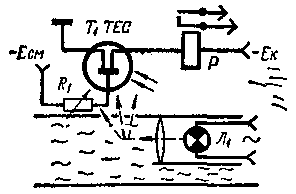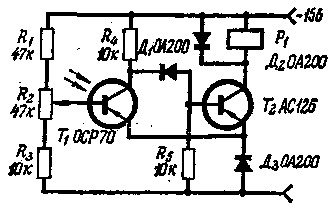To fire the device, the principle of which is shown in Fig. 1, the phototransistor is used with a field effect, having high sensitivity to changes in illumination. Luminous flux from a light bulb L1 is parallel to the window phototransistor, and in the absence of smoke, the current through the phototransistor does not leak.

Fig. 1
The appearance of even a mild smoke causes scattering of light, part of which is within the window of the phototransistor. Collector current under the influence of the light flux increases, the actuation of the actuating relay R, which includes their contacts power circuit devices, providing an alarm.
For similar purposes may be used by the phototransistor, which is part of the trigger, assembled according to the diagram of Fig. 2.

Fig. 2
Light control in this device is as follows. In the waiting state, the transistor T1 is illuminated, and through him, the current flows through the transistor T2 and the relay coil R1, the current does not leak. Darkening of the light flux reduces the current through the phototransistor. Transistor Tg goes into saturation, its collector current causes the relays and the circuit contacts in the supply circuit of the alarm device.
Literature
Publication: www.cxem.net






